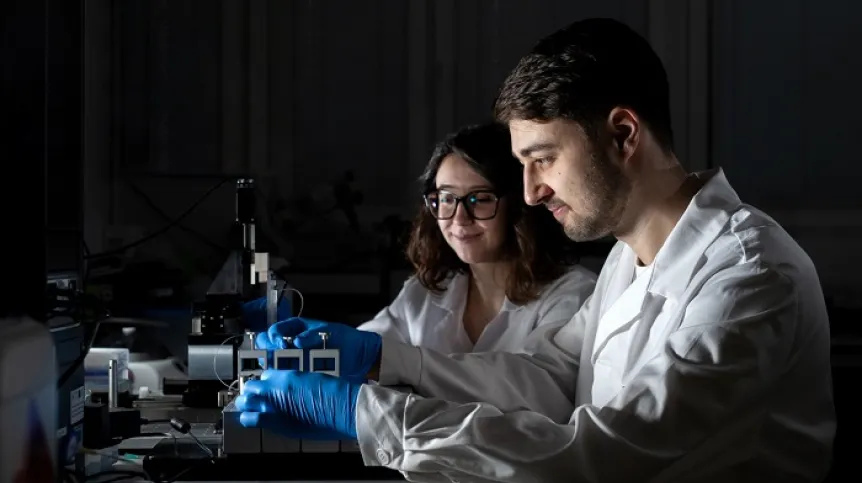
Porous materials are essential for many chemical processes, such as light harvesting, adsorption, catalysis, energy transfer and even new technologies for electronic materials. Therefore, many efforts have been made to control the porosity of any different manufactured materials.
To address this, researchers at the Institute Physical Chemistry of the Polish Academy of Sciences recently demonstrated a novel microfluidic technology that allows to generate emulsions with dynamic control over the droplet volume to modify the chemical composition of the 3D printed matrix on a large scale using aligned nozzles to deliver porous materials with fully controlled porosity.
Porous materials with controlled shape and pore size are in high demand in a wide range of fields, from chemical synthesis and environmental research to the energy production sector. Depending on the chemical composition of the material, porosity can be achieved by foaming, extrusion, slip casting, granulation, electrospinning, spray drying, granulation, emulsification and many other methods, including where the list of manufacturing methods is much longer.
Regardless of the technique used, control of pore size and shape within these techniques still has several limitations. Whichever of the shape of the pores, cavities, channels or fissures, which are cylindrical, ink-bottle or funnel-shaped, spherical or other, controlling their size, shape and gradual distribution in the material is still a challenge. Especially when it comes to preparing large-scale functional structures.
However, thanks to the design of a novel microfluidic module proposed by researchers at the Institute of Physical Chemistry of the Polish Academy of Sciences (IPC PAS), it is possible to produce porous materials with controlled pore size and distribution throughout the volume of the synthesized material.
The researchers combined the microfluidic device with a custom 3D printer, where by generating and extruding an oil-in-water emulsion in an agarose gel bath, followed by polymerization, it was possible to control the unique structure in the 3D printed hydrogel. Nevertheless, it all started with the application of microfluidic technologies that allow the control of the flow of immiscible fluids in tiny microchannels to generate small droplets with a consistent volume ranging from femtoliters to nanoliters.
Although such technology is well known around the world and has been widely developed for three decades, most of the methods produce droplets with a volume that greatly depends on the flow rates. Due to this aspect, controlling the droplet diameter during the 3D extrusion of the emulsion is a challenging task, since the flow rate should be maintained constant. In a recent paper published in the journal "Lab on the Chip", researchers from IPC PAS suggested a new microfluidic technology to dynamically control the droplet diameter without changing the extrusion rate of the emulsified phases.
The scientists combined an existing technology (step emulsification) with a flexible membrane that allowed to change the nozzle geometry adjusting the pressure on the membrane. A decrease in the nozzle height reduced the droplet diameter over three orders of magnitude and was successfully tested for different flow rates. This tunable step (also known as tuna-step) allowed to generate Oil-in-Water (O/W) and Water-in-Oil (W/O) emulsions with changes in droplet size and volume fraction while maintaining a constant extrusion rate.
Dr. Marco Costantini claims “In our work, we demonstrated how the change of nozzle geometry can control the droplet size and volume fraction. Here, we first analysed how tuna-step can be effectively used both for the production of W/O and O/W emulsions, the latter being possible thanks to an innovative hydrophilic PDMS surface modification strategy that we additionally developed. Following that, we integrated tuna-step within a custom 3D printing platform and extruded O/W emulsions into a granular agarose fluid–gel bath. This strategy allows to further separate the rheological properties of the emulsion ink from its printability and achieve precise spatial positioning during the extrusion process.”
Since two different configurations were used to create oil-in-water emulsions, the researchers created a custom hydrophilic modification of the chip's surface with polydimethylsiloxane (also known as PDMS) to prevent it from swelling when exposed to organic solvents such as hexadecane. This procedure allowed us to generate oil droplets in water continuously for nearly 24 hours, which, combined with 3D printing technology, enabled printing combined with polymerization of functionally graded materials of varying porosity and composition.
So far, with the proposed experimental setup, combining gradients of composition, microarchitecture or both types of gradients in a single material can create many types of many different materials with distinctive structural and functional characteristics.
The findings described above not only show that our tuna-step design is suitable for 3D printing of emulsions and material science, but also demonstrate potential future applications. In addition, 3D printing can be performed using multiple nozzles simultaneously, making the proposed setup a versatile tool for producing porous materials.
“Our versatile design enabled us to additionally achieve multi-material 3D deposition by rapidly switching between different continuous phases. Finally, we demonstrated the scalability potential of our tuna-step by producing droplets using a 14-nozzle device, increasing the system throughput by a factor of ∼14, an aspect particularly important for the manufacturing of macroscopic hydrogel with the controlled porosity within the whole volume”. – remarks dr. Marco Costantini.
Why is controlled porosity so important? As mentioned, there are many sectors that deal with this feature, from energy, such as porous matrix for supercapacitors, to soft tissue reinforcement biocomponents. The proposed project closes us to the easy production of porous substructures with controlled design, much like bone or cartilage implants having gradual porosity, but the list of materials that can be produced using the proposed technology is certainly much longer.
Source: https://ichf.edu.pl/en/press/drop-the-drop
kap/













